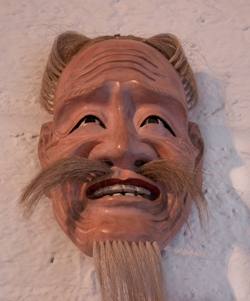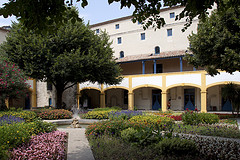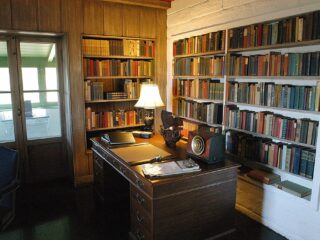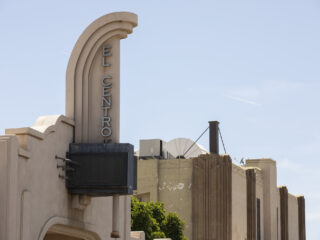As the shuttle bus edges up the last grade of the gated private road, the morning fog has settled like smoke in the cup of green hills. To the right, white brick walls enclose the Spanish-style ranch home of playwright Eugene O’Neill and his wife, the stage actress Carlotta Monterey, who lived in this secluded setting from 1937 to 1944. Veiled in mist overlooking the San Francisco East Bay’s San Ramon Valley, the house appears nearly invisible, alone, without a trace of human presence.
On the driveway’s left, two cows, grazing in a meadow, move through the thick gray fog like ghosts. A small orchard of bare walnut trees, originally planted by O’Neill, and an old weathered white barn border it. Beyond, the steep hills of the Las Trampas Regional Wilderness fold into ridges and arroyos covered with pine, manzanita and madrone.
“O’Neill loved being in this healing environment,” says our National Parks guide Ron Neuhauser. “He loved the fog, the remoteness of this place, of being surrounded by nature. It freed his creative impulses. It allowed him to write.”?
The O’Neills’ love affair with the valley began in 1936, when the Pulitzer Prize winning dramatist, anxious to escape his growing fame, came west to visit a friend in Seattle. During the visit, he was notified of being awarded the Nobel Prize in Literature: an honor that no other American playwright has received.
With money from the award, Eugene and Carlotta bought 158 hillside acres for $17,500 in the Spring of 1937. Formerly part of a large Spanish land grant, the Rancho San Ramon, the property included the gable-roofed barn, and an old adobe farmhouse, which was knocked down in order to build the couple’s beloved Tao House.
Today, the National Park Service manages and maintains Tao House and the surrounding 13 acres in conjunction with the Eugene O’Neill Foundation.
The name, Tao House, reflected Eugene and Carlotta’s keen interest in Chinese culture. In 1928, they traveled through Asia stopping in Shanghai. Four wrought-iron Chinese characters spelling out Tao House, (Tao means, the “right way of life”) adorn the black courtyard gate.
Carlotta, who had studied Daoist (or Taoist) philosophy and Chinese art and history since she was 13, supervised the house’s construction, Ron tells us as we enter the courtyard, “She and Eugene were familiar with the ideas of feng shui the–Chinese belief that the orientation or arrangement of things can bring harmony between negative and positive energies of the universe.”
All of us immediately notice that the brick pathway leads to the doorway of the house at right- angled turns. “According to feng shui, evil spirits travel in straight lines,” explains Ron. “The zigzag pattern would ward them off.”
The house is filled with Chinese motifs and decor. In the entranceway, a green-colored mirror covers the wall behind the front door. Reproductions of three Japanese Noh masks representing a young woman, an older woman, and a jealous woman hang below the stairwell. African masks decorate the wall above it.
Masks were used in many of O’Neill’s plays, says Neuhauser. “They are symbolic of his belief that people hide their true natures. He had been influenced by European and Japanese playwrights.”
Tao House is a dark house. The windows are spaced far apart because Carlotta’s eyes were sensitive to light. The colors are cool: flat white walls, blue ceilings and dark brown floors representing heaven and earth. A brooding silence lingers in the corridors and rooms. The house was clearly built to provide solitude, not gaiety or festivity.
The living room has a large woven Chinese carpet and built-in, ceiling-high bookshelves on both sides of the entrance. “O’Neill owned over 8,000 books,” Ron says. “He read everything from Greek tragedies and histories on the Ancient World to post-colonial and revolutionary works by (Frederick) Nietzsche and (Karl) Marx, and modern writers and playwrights like (Joseph) Conrad, (Jack) London, (Henrik) Ibsen and (August) Strindberg.”
The photographs mounted on an easel near the fireplace are from a 1941 visit by Life magazine. The O’Neills are seated in their beautifully furnished French Continental and Chinese-themed living room, both engrossed in their reading, appearing attractive and smartly dressed. A dark wood lacquered Coromandel screen graces the doorway. Carlotta bought these and other furnishings, including Eugene’s couch bed of carved teak with rattan webbing, from Gump’s in San Francisco, an upscale importer of fine wares.
When Gump’s refused to sell the bed to the Eugene O’Neill Foundation, the actress Katherine Hepburn, an honorary board member of the Foundation, wrote a letter to the store management in 1992, addressed mockingly “Dear Gump, What can I give you to sell back the bed? Think and be kind; you are Gump’s.” Thanks to her intercession, the bed is now back at Tao House in O’Neill’s upstairs bedroom.
In a small room off the front hallway, O’Neill would, in lighter moments, pump out old barroom tunes, ragtime and sea shanties on “Rosie” a 1910 electric player piano from a New Orleans bordello. The Foundation found the exact model to replace the original.
The walls are covered with photographs of family and friends: Eugene’s father, James O’Neill, who was a prominent Irish-born New York stage actor, Eugene’s mother Ella Quinlan, a native of Ohio and trained musician, the Irish writer Sean O’Casey, stage and film actress Sarah Bernhardt, and English playwright Somerset Maugham.
Two small, stylized lion statues, a feature commonly found outside of Chinese temples to ward off evil spirits, guard the foot of the stairs. Original to Tao House, their function was to support “the master”, as Carlotta often called Eugene, while he worked in his upstairs study undisturbed.
Under Carlotta’s watchful management, Tao House provided O’Neill with a refuge, a retreat from the glare of fame where he found the solitude and inspiration to write his most important plays. She managed the home and servants, handled his correspondence, transcribed his plays and letters, and cared for him when he was ill or emotionally distraught.
“She sacrificed a large part of herself–her career in theater and her friends back East–for the benefit of Eugene,” the lead ranger Randy Harabin tells me. “She created an environment where he could concentrate on his work without distractions.”
The O’Neills seldom entertained at Tao House, and visitors came only by invitation from Carlotta. “She acted as a buffer to the outside world, a gatekeeper,” says Harabin. On average there were about 25 visits a year, over half of them by O’Neill’s children–Eugene Jr., Shane and Oona–from his two previous marriages.
Carlotta was essential to O’Neill’s creative life. “His plays became her raison d’etre…her pride and in a measure her love,” writes the literary scholar Travis Bogard. O’Neill was certainly aware of this. In the dedication to Mourning Becomes Electra, written in 1929, the year they were married in Paris, he refers to her as his “mother and wife, and mistress and friend! And collaborator!”
Until he came to Tao House, Eugene had been a wanderer–a man–seeking flight from a troubled, self-destructive life plagued by depression and alcoholism. Born in 1888, he grew up in the wings of theaters, in hotel rooms on his father’s road trips, before being freighted off to Catholic boarding schools and Princeton, where he flunked out in 1907.
Always the introvert, he sought escape from his withdrawn, morphine-addicted mother, miserly father whose greatest fear was poverty, and drunken, suicidal brother. He abandoned his pregnant wife to work as a gold prospector in Honduras, and later signed on as a common seaman, living as a tramp on the streets of Buenos Aires. Life hit rock bottom when he returned to New York in 1911 and later moved into a Hell’s Kitchen flophouse where he attempted suicide. Here, his flight at last came to a forced pause when he fell ill with tuberculosis.
While recovering in a Connecticut state sanitarium, O’Neill began to write, slowly and tentatively at first. Writing gave him life, a way to stop running and face his ghosts. From his first plays staged at Provincetown, Massachusetts, he would emerge as America’s preeminent playwright, winning Pulitzer Prizes for Beyond the Horizon (1920), Anna Christie (1922) and Strange Interlude (1928).
These plays set a new direction in playwriting. Clearly repelled by melodrama with its contrived plots and stilted acting, O’Neill wanted to dramatize people’s inner psychological states–their struggles with powerful, unconscious forces that they neither understood nor controlled. He achieved this in his plays through the use of masks, soliloquies and extended asides with the action frozen. He was the first American playwright to cast black actors, including Paul Robeson, in leading or serious roles and to treat the poor and powerless in a non-sentimental way.
“He had a revolutionary impact on the American theater,â? says Harabin. â??He took it from the stylized melodrama of his father’s day to drama that dealt with the cold hard truth of life, with the human condition whether it be alienation, prostitution, alcoholism, race relations or the industrial underclass. And he drew upon his experiences to translate the stuff of his life into his most memorable work here at Tao House.”
At Tao House, O’Neill followed a disciplined regimen, writing in the morning until noontime and then eating lunch and relaxing, usually swimming in the pool or hiking in the hills with Blemie, his beloved Dalmatian. His bouts with alcohol were rare.
Along with Rosie’s Room, the upstairs study is the only room furnished as it looked in his time. It has an ambiance strikingly different from the rest of the house. There is no trace of things Eastern.
Built like a sea captain’s cabin with timbered ceiling beams and wood-paneled walls and packed with memorabilia from O’Neill’s seafaring days, the little room became his atelier. There are no publicity shots, prestigious awards or other commendations. O’Neill was a very private and unpretentious person. The only document displayed in the room is his Bureau of Navigation discharge papers. A model of a clipper ship sits on one of the bookshelves. “This is a final home and harbor for me,” the playwright once said.
With its books, dark floor, and sailing memorabilia, the study was O’Neill’s anchor to his past. It allowed him to go inside himself to face his family, and the sailors and other roustabouts of his youth. All of them were now dead, gone to ashes–their ghosts flooding his memory to come alive in his plays.
“The sea had an enormous influence on him and, strange as it may sound, this room â?? its design as a ship captain’s quarter–reconnected him to it. The sea was his first safe harbor,” exclaims Randy.
Here, undisturbed and in utter silence, O’Neill would write six plays, including such masterpieces as The Iceman Cometh (1939), Long Day’s Journey Into Night (1941) and A Moon for the Misbegotten (1943).
The Iceman Cometh, which is set in a waterfront dive in Hell’s Kitchen, dramatizes the camaraderie of down-and-out men who cling to the “lie of the pipe dream”, to gain some sense of being alive. In A Moon for the Misbegotten, O’Neill confronts the death of his mother and the agony his helplessly drunken brother Jaime felt for failing her. Long Day’s Journey Into Night, which is based on his family, is a searing portrayal of the twisted interactions among the four Tyrones, who forever seek exoneration and forgiveness as they admit and then deny their offenses. Without question his tour de force, it won for O’Neill a fourth Pulitzer in 1957, four years after his death.
In a letter written to John Chapman of the New York Times on November 20, 1956, Carlotta recounted the inner agony that literally possessed O’Neill while writing this tragedy:
He would come out of the study with sunken cheeks, eyes red from weeping–physically and mentally exhausted. Night after night I had to hold him tight in my arms so he could relax and sleep. If I tried to change my position, he would wake and plead with me ‘don’t go, please–hold me tight.’ Thus, the play was written–it was a very large part of him.
Like so many writers during this time, the playwright had been profoundly affected by the Great Depression and Second World War. Read against the backdrop of hunger and unemployment and black-booted soldiers raising swastikas, the plays and manuscripts written at Tao House offer no panaceas, no social or political remedies. His characters were cast adrift in a world without anchors. They could survive only when they put their trust in one another, no matter how delusionary or hopeless their dreams appeared to be.
Tao House regrettably was not O’Neill’s final home or harbor. The war changed that. The servants, including Herbert Freeman, the couple’s trusted handyman and chauffeur, left to enlist in the military or to enter the war industries. Neither Carlotta nor Eugene could drive. Gasoline rationing made errands difficult, and the increasing severity of their ailments left them “…just about marooned on our hill now,” wrote Eugene in early 1943.
By this time, a neuromuscular disorder had begun to cause severe tremors in his hand, making it difficult and sometimes impossible for him to write. His writing became increasingly microscopic. The tremor was a veritable death knell for O’Neill’s career since he could neither type nor dictate his material.
In 1944, the couple sold Tao House and returned to the East Coast, where Eugene’s inability to write, the suicide of his son Eugene Jr. and the couple’s constant quarreling made life unbearable and separation inevitable. Eugene and Carlotta would reconcile shortly before his death.
His life ended, as it had begun, in a Boston hotel room, where he died with Carlotta by his side on November 27, 1953. His last recorded words, spoken perhaps with the memory of his creative years at Tao House in mind, were: “Born in a hotel room, and God damn it, died in a hotel room.”
Eugene O’Neill received the Nobel Prize in Literature “for the power, honesty and deep-felt emotions of his dramatic works, which embody an original concept of tragedy.” As an artist, he was absolutely committed to laying bare humanity’s maimed soul, with divulging the truth no matter how painful, delusional or contrary it might be. His vision was tragic. The characters in his plays struggle with their private sins, personal obsessions, broken dreams and conditions–with forces, unconscious and incomprehensible, that pull them down. But he was never a fatalist because people in his plays, as in his life, possess the capacity to make choices. “Tragedy…gives Man a tremendous significance,” he once said, “(and) fate can never conquer his–or her–spirit.”
Please continue reading Victor Walsh’s “Behind The Article” interview to find out more about Eugene O’Neill’s Tao House.
*
More Articles on Asian Influence
Divine Inspiration at The Oriental Hotel in Bangkok
A Murakami-esque Day: Banalities & Absurdities in Beijing
China’s Lin Yutang: Caught Between East and West
Purchase Ereaders
Buy Eugene O’Neill Ebooks
Travel to San Francisco
Get the best Digital Cameras and Travel Cameras
Take an Eugene O’Neill Tour
Visit Historic Hotels in San Francisco
Discuss Eugene O’Neill on LiteraryTraveler.net










